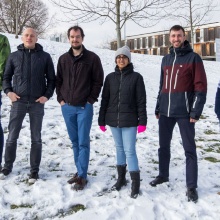- News
-
The Physical Optics Group is moving to the University of Graz. We offer several new positions. For further information, please take a look at the homepage or contact Prof. Thomas Weiss (thomas.weiss@uni-graz.at).
- Overview
-
The junior research group “Physical Optics” has been established at the University of Stuttgart in order to bridge the gaps between physicists and engineers as well as experimental and theoretical physics. It is part of the Research Center SCoPE, where several institutes of the physics and engineering departments collaborate in highly active research areas of optics and quantum technologies. The research activites include nanooptics, plasmonics, photonic crystal fibers, display technologies, solar cells, quantum optics, and a lot more.
- Research Interests
-
The focus of the junior research group "Physical Optics" is on the theoretical and numerical calculations for investigating the optical properties of micro and nanostructures. This includes design optimization, development of advanced numerical methods as well as gaining a deeper insight by semi-analytical approaches. For the latter, we are using coupled-oscillator models as well as the resonant state expansion, where the resonant states of a given system are used as the basis for describing its optical response. A strong emphasis lies on chiral and non-reciprocal plasmonics as well as hybrid systems combining photonic and quantum technologies, particularly plasmonic systems and quantum emitters such as strongly interacting atoms, molecules, and quantum dots.
- Methods
-
Our numerical expertise is based on in-house numerical tools such as Fourier modal method with adaptive coordinates, split-step Fourier method, resonant state expansion, and beam propagation method, as well as on commercial finite element and finite difference time domain software.
- Selected publications
-
- On the pole expansion of electromagnetic fields
J. Defrance and T. Weiss
Opt. Express 28, 32363 (2020). - DNA-assembled nanoarchitectures with multiple components in regulated and coordinated motion
P. Zhan, M. Urban, S. Both, X. Duan, A. Kuzyk, T. Weiss and N. Liu
Science Advances 5, eaax6023 (2019). - First-order perturbation theory for changes in the surrounding of open optical resonators
S. Both and T. Weiss
Opt. Lett. 44, 5917 (2019). - Analytic mode normalization for the Kerr nonlinearity parameter: Prediction of nonlinear gain for leaky modes
I. Allayarov, S. Upendar, M. Schmidt and T. Weiss
Phys. Rev. Lett. 121, 213905 (2018). - Analytical mode normalization and resonant state expansion for bound and leaky modes in optical fibers - an efficient tool to model transverse disorder
S. Upendar, I. Allayarov, M. Schmidt and T. Weiss
Opt. Express 26, 22536 (2018). - Gold nanocrystal-mediated sliding of doublet DNA origami filaments
M. Urban, S. Both, C. Zhou, A. Kuzyk, K. Lindfors, T. Weiss and N. Liu
Nat. Commun. 9, 1454 (2018). - Modeling of second-harmonic generation in periodic nanostructures by the Fourier modal method with matched coordinates
J. Defrance, M. Schäferling and T. Weiss
Opt. Express 26, 13746 (2018). - How to calculate the pole expansion of the optical scattering matrix from the resonant states
T. Weiss and E. Muljarov
Phys. Rev. B 98, 085433 (2018). - Resonant-state expansion for open optical systems: Generalization to magnetic, chiral, and bi-anisotropic materials
E. Muljarov and T. Weiss
Opt. Lett. 43, 1978 (2018). - Line-current model for linear and nonlinear optical properties of thin elongated metallic rod antennas
M. Nesterov, M. Schäferling, K. Weber, F. Neubrech, H. Giessen and T. Weiss
J. Opt. Soc. Am. B 35, 1482 (2018). - Highly Sensitive Refractive Index Sensors with Plasmonic Nanoantennas - Utilization of Optimal Spectral Detuning of Fano Resonances
M. Mesch, T. Weiss, M. Schäferling, M. Hentschel, R. Hedge and H. Giessen
ACS Sensors 3, 960 (2018). - Analytical Normalization of Resonant States in Photonic Crystal Slabs and Periodic Arrays of Nanoantennas at Oblique Incidence
T. Weiss, M. Schäferling, H. Giessen, N. Gippius, S. Tikhodeev, W. Langbein and E. Muljarov
Phys. Rev. B 96, 045129 (2017). - Lorentz Nonreciprocal Model for Hybrid Magnetoplasmonics
D. Floess, T. Weiss, S. Tikhodeev and H. Giessen
Phys. Rev. Lett. 117, 063901 (2016). - The role of plasmon-generated near-fields for enhanced circular dichroism spectroscopy
M. Nesterov, X. Yin, M. Schäferling, H. Giessen and T. Weiss
ACS Photonics 3, 578 (2016). - Reducing the complexity: Enantioselective chiral near-fields by diagonal slit and mirror configuration
M. Schäferling, N. Engheta, H. Giessen and T. Weiss
ACS Photonics 3, 1076 (2016). - From Dark to Bright: First-Order Perturbation Theory with Analytical Mode Normalization for Plasmonic Nanoantenna Arrays Applied to Refractive Index Sensing
T. Weiss, M. Mesch, M. Schäferling, H. Giessen, W. Langbein and E. Muljarov
Phys. Rev. Lett. 116, 237401 (2016). - Matched coordinates and adaptive spatial resolution in the Fourier modal method
T. Weiss, G. Granet, N. Gippius, S. Tikhodeev and H. Giessen
Opt. Express 17, 8051 (2009).
- On the pole expansion of electromagnetic fields

Thomas Weiss
Prof. Dr.Professor for Theoretical Nanophysics at the University of Graz



